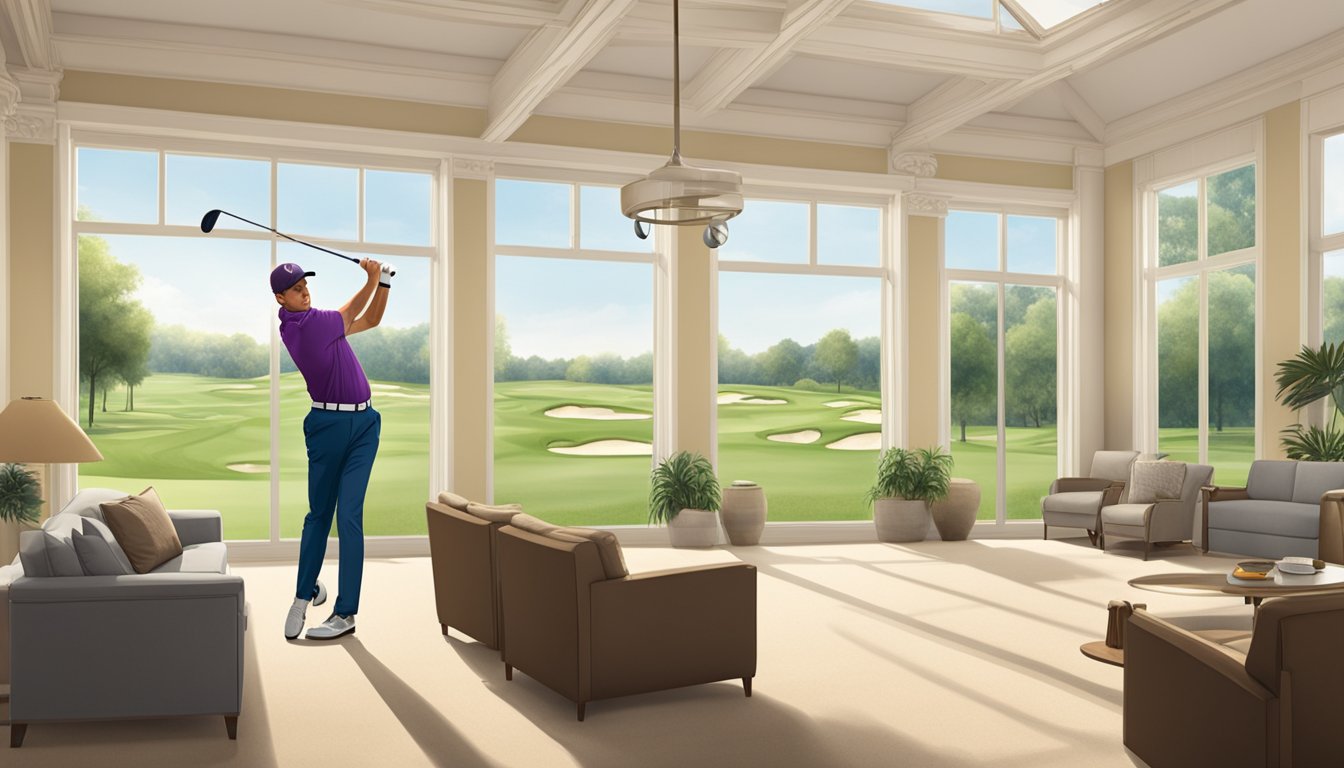If you’re new to golf, you may have heard the term “loft” used when referring to golf clubs. So, what does it mean? In simple terms, loft is the angle of the clubface in relation to the shaft. The amount of loft a club has can significantly impact the trajectory of the ball, making it an essential factor to consider when choosing the right club for your shot.


Understanding loft in golf is crucial if you want to improve your game. The loft of a club can affect how high the ball travels, how much spin you can put on it, and how far it will travel. Clubs with higher lofts, such as wedges and irons, are better suited for shots that require a high trajectory and more spin, while drivers and fairway woods typically have lower lofts to help the ball travel farther.
In this article, we’ll explore the impact of loft on ball flight, how to choose the right loft for your shot, and the different lofts found in various golf clubs. We’ll also cover some advanced concepts in loft and answer some frequently asked questions. By the end of this article, you’ll have a better understanding of loft in golf and how it can help you improve your game.
Key Takeaways
- Loft is the angle of the clubface in relation to the shaft and can significantly impact the trajectory of the ball.
- Clubs with higher lofts are better suited for shots that require a high trajectory and more spin, while clubs with lower lofts are better for shots that require more distance.
- Understanding loft in golf is crucial if you want to improve your game.
Understanding Loft in Golf
https://www.youtube.com/watch?v=XoLxbgO2qoE&embed=true
Basics of Loft
Loft is a crucial factor in golf that affects the trajectory and distance of a golf ball. It refers to the angle created between the clubface and the ground. The more loft a golf club has, the higher the ball will launch. For example, a wedge has a higher loft than a driver, which means it will launch the ball higher in the air.
Loft is an essential factor in determining the type of shot you can make. A higher lofted club is ideal for shots that require the ball to travel higher in the air, such as bunker shots or approach shots. On the other hand, a lower lofted club is ideal for shots that require the ball to travel a longer distance, such as tee shots.
Loft and Club Types
Different clubs have different lofts, and this affects the type of shots you can make with them. Here is a brief overview of the lofts of different golf clubs:
Wedges: Wedges have the highest lofts among all golf clubs, ranging from 46 to 64 degrees. They are ideal for shots that require the ball to travel a short distance and launch high in the air, such as bunker shots or chip shots.
Irons: Irons have a range of lofts, typically ranging from 18 to 48 degrees. Lower-numbered irons have lower lofts and are ideal for long shots, while higher-numbered irons have higher lofts and are ideal for shorter shots.
Driver: Drivers have the lowest lofts among all golf clubs, typically ranging from 8 to 13 degrees. They are ideal for tee shots and shots that require the ball to travel a long distance.
Hybrid: Hybrids are a cross between irons and woods and have a range of lofts, typically ranging from 16 to 29 degrees. They are ideal for shots that require the ball to travel a moderate distance and launch high in the air.
Putter: Putters have the lowest lofts among all golf clubs, typically ranging from 2 to 6 degrees. They are ideal for shots on the green and require the ball to roll along the ground rather than launch high in the air.
Understanding the basics of loft and how it affects different types of golf clubs is crucial in improving your golf game. By selecting the right club with the appropriate loft for each shot, you can achieve better results and lower your score.
Impact of Loft on Ball Flight
https://www.youtube.com/watch?v=sVZCXWPxZvQ&embed=true
If you’re a golf enthusiast, you know that the loft of your club is an essential factor that can significantly impact your ball’s flight. Here are some of the ways that loft can affect your shots.
Loft and Launch Angle
The loft of your clubface can determine the angle at which your golf ball takes off from the ground. Clubs with higher lofts, such as wedges, can launch the ball higher into the air, while clubs with lower lofts, such as drivers, can launch the ball lower. Understanding the relationship between loft and launch angle can help you select the right club for the shot you need to make.
Loft and Distance
The loft of your club can also affect the distance your ball travels. Generally, clubs with lower lofts, such as drivers, can hit the ball farther than clubs with higher lofts. However, the loft of your club is not the only factor that determines the distance your ball travels. For example, a poorly struck shot with a low-lofted club may not travel as far as a well-struck shot with a higher-lofted club.
Loft and Spin
The loft of your club can also affect the amount of spin your ball has. Clubs with higher lofts can create more backspin, which can help your ball stop more quickly on the green. Conversely, clubs with lower lofts can create more sidespin, which can cause your ball to curve in flight. Understanding the relationship between loft and spin can help you select the right club for the shot you need to make.
In summary, the loft of your club plays a significant role in determining the trajectory, lift, height, and distance of your golf ball’s flight. By understanding how loft affects your shots, you can select the right club for the shot you need to make and improve your overall performance on the golf course.
Choosing the Right Loft
https://www.youtube.com/watch?v=HcTBZ8u5ZaM&embed=true
Choosing the right loft is crucial for golfers of all skill levels. It can help you hit the ball higher and farther, and ultimately improve your game. In this section, we’ll take a look at how to choose the right loft based on your skill level and swing speed.
Loft Based on Skill Level
As a beginner, you may want to start with a higher lofted club, such as a 9-iron or a pitching wedge. These clubs have a higher loft angle, which can help you get the ball in the air easier. As you improve your swing and gain more control, you can start to use lower lofted clubs, such as a 7-iron or a 5-iron.
For intermediate and advanced players, choosing the right loft depends on the range, control, accuracy, and consistency you want to achieve. You may want to use a lower lofted club for longer shots, or a higher lofted club for shorter shots that require more accuracy.
Loft Based on Swing Speed
Your swing speed is another important factor to consider when choosing the right loft. If you have a slower swing speed, you may want to use a higher lofted club to help get the ball in the air. On the other hand, if you have a faster swing speed, you may want to use a lower lofted club to help control the ball and achieve more distance.

Here’s a table that shows the recommended loft based on your swing speed:
| Swing Speed | Recommended Loft |
|---|---|
| Less than 60 mph | 12-15 degrees |
| 60-75 mph | 10-12 degrees |
| 75-85 mph | 8-10 degrees |
| 85 mph or more | 6-8 degrees |
Remember, choosing the right loft is not an exact science. It may take some trial and error to find the right club for you. But with practice and patience, you’ll be able to find the perfect loft that helps you achieve your golfing goals.
Loft in Different Golf Clubs
https://www.youtube.com/watch?v=38tcHcCmkGY&embed=true
When it comes to golf clubs, loft is an essential factor that determines the trajectory and distance of your shots. Each club has a different loft angle, which affects the angle at which the ball leaves the clubface. Here’s a breakdown of loft in different golf clubs to help you understand how it impacts your game.
Loft in Drivers
Drivers are the longest clubs in your bag and have the lowest loft angle, typically ranging from 9 to 12.5 degrees PGA. The lower the loft, the less backspin on the ball, which means it will travel farther. However, lower loft also means less lift, making it harder to get the ball in the air. A higher lofted driver will help you get the ball airborne more easily, but it will sacrifice some distance.

Loft in Irons
Irons have a higher loft angle than drivers, ranging from 18 to 48 degrees Golfspan. The lower numbered irons (2-4) have lower loft angles and are designed for longer shots, while the higher numbered irons (5-9) have higher loft angles and are used for shorter shots. The higher loft on irons helps create more backspin on the ball, which helps it stop faster on the green.
Loft in Wedges
Wedges are specialty clubs with the highest loft angles, ranging from 46 to 64 degrees Golfbit. Wedges are used for short shots around the green and in bunkers. The high loft on wedges creates a lot of backspin, which helps the ball stop quickly when it hits the green. Wedges come in different types, including pitching wedges, sand wedges, and lob wedges, each with a different loft angle.
Loft in Putters
Putters are the only club in your bag without a loft angle. The putter’s face is designed to hit the ball squarely, with no loft, to help it roll smoothly on the green. However, some putters have a slight loft angle, ranging from 1 to 6 degrees Golfercloud. This loft angle helps the ball roll more smoothly and reduces the chance of it bouncing or skidding off the green.
In conclusion, understanding the loft angle of your golf clubs is crucial for improving your game. Lower loft angles on drivers and irons will help you hit the ball farther, while higher loft angles on wedges and putters will help you control the ball’s spin and direction. Keep this in mind when selecting the right club for each shot and watch your game improve.
Advanced Concepts in Loft
https://www.youtube.com/watch?v=e7DkOUAlEHk&embed=true

As you progress in your golf game, you’ll come across advanced concepts in loft that can help you take your skills to the next level. Here are a few important concepts you should know:
Dynamic Loft
Dynamic loft is the angle of the clubface at impact, which can be different from the static loft of the club. This is because the shaft of the club bends during the swing, which can change the angle of the clubface. Understanding dynamic loft can help you make better club selections and adjust your swing to achieve the desired ball flight.
Loft and Bounce
Bounce is the angle between the leading edge and the sole of the club. It helps the club glide through the turf and prevent digging. The amount of bounce you need depends on the type of shot you’re making and the conditions of the course. A higher bounce angle is better for softer turf, while a lower bounce angle is better for firmer turf.
Loft and Grind
Grind refers to the shaping of the sole and leading edge of the club. Different grinds can affect how the club interacts with the turf and how it enters the sand. For example, a grind that removes material from the trailing edge can make it easier to hit out of the sand. Understanding the different grinds can help you choose the right club for the shot you’re making.
Overall, understanding advanced concepts in loft can help you make better club selections, adjust your swing, and improve your ball flight. Keep in mind that other factors, such as contact and roll, also affect the outcome of your shot. Practice and experimentation can help you find the right combination of loft and other factors for your game.
Frequently Asked Questions

What are high loft irons used for in golf?
High loft irons, also known as wedges, are used for short shots around the green. They have a higher loft angle, which makes the ball go up higher and land softer. They are also used for bunker shots and chipping around the green. Wedges come in different types, including pitching wedge, sand wedge, lob wedge, and gap wedge.
What are some basic golf clubs for beginners?
If you’re a beginner, it’s best to start with a basic set of clubs that includes a driver, fairway woods, irons, wedges, and a putter. The driver is used for long shots off the tee, while fairway woods are used for long shots from the fairway. Irons are used for shots from the fairway or rough, while wedges are used for short shots around the green. The putter is used on the green to roll the ball into the hole.
How does the loft of a golf club affect your swing?
The loft of a golf club affects the trajectory and distance of your shot. A club with a higher loft will launch the ball higher and with less distance, while a club with a lower loft will launch the ball lower and with more distance. The loft also affects the amount of backspin on the ball, which can help it stop quickly on the green.
What is the loft of a typical golf iron?
The loft of a typical golf iron varies depending on the number of the club. A 3-iron has a loft of around 21 degrees, while a 9-iron has a loft of around 44 degrees. The higher the number, the higher the loft angle. The loft angle is important because it affects the trajectory and distance of your shot.

How do golf club lofts affect distance?
Golf club lofts affect distance in that a club with a lower loft will typically hit the ball farther than a club with a higher loft. This is because a lower lofted club will have less backspin and more roll, resulting in more distance. However, it’s important to note that a higher lofted club can be more accurate and easier to control, especially on shorter shots.
What is the difference between loft and lie in golf clubs?
The loft of a golf club refers to the angle between the clubface and the shaft. The lie of a golf club refers to the angle between the sole of the club and the ground when the club is at address. The lie angle is important because it affects the direction of the shot. If the lie angle is too upright, the shot will go to the left. If the lie angle is too flat, the shot will go to the right.










